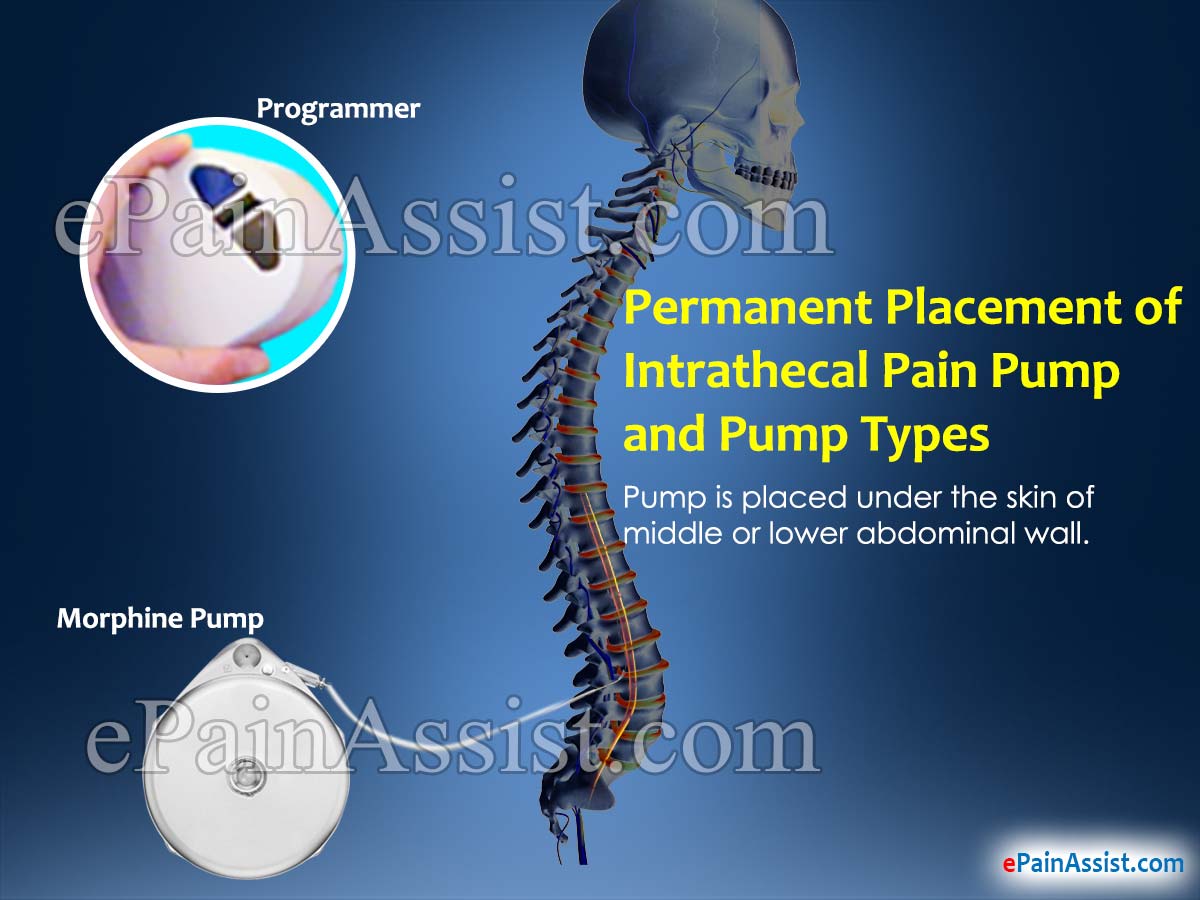- In this article, the following sections are covered:
- Permanent Placement of Intrathecal Pain Pump
- Insertion of Intrathecal Catheter
- Placement of Intrathecal Pain Pump
- Types of Intrathecal Pain Pump
- Post Operative Observation in Recovery Room
Permanent Placement of Intrathecal Pain Pump
Intrathecal medication delivery system consists of intrathecal catheter and pump. Patient is considered for placement of intrathecal catheter and pain pump after successful intrathecal opioid trial. Patient is carefully selected for surgery following psychological evaluation to rule out psychological pain. Catheter insertion and placement of pump is performed surgically in outpatient surgery. Two skin incisions are performed to insert pump and catheter. Pump is mostly inserted under the abdominal skin on either side of the umbilicus (belly button). Skin insertion for the catheter is taken over the spine between third and forth lumbar vertebrae.

Anesthesia-
- Procedure is performed under sedation and local anesthesia. After sedation, local anesthetics 1% lidocaine is injected under skin, subcutaneous tissue and ligaments. Procedure is performed after testing the effects of local anesthesia. Anesthesia is supervised and conducted by independent anesthesiologist.
Insertion of Intrathecal Catheter –
- Patient lies in lateral decubitus position.
- Skin incision of 1.5 cm is taken and extended to supra-spinous ligament.
- Spinal needle is inserted under X-ray into spinal fluid between the upper and lower spine at level L3 to L5. Catheter is threaded through spinal needle using X-ray.
- Proximal end of catheter tip is placed at the level of L2 or L1 and position of tip of catheter is confirmed using X-Ray (image intensifier).
- Catheter is anchored to supra-spinous ligament with anchoring device using appropriate sutures.
- Distal end of catheter is passed through tunnel passer into anterior abdominal pump pocket after catheter is secured to supra-spinous ligament. Tunnel passer is metallic tube, which is passed under the skin from catheter pocket to pump pocket.
- Tunnel passer is removed once distal end of catheter is secured in pump pocket. The posterior catheter pocket is irrigated with antibiotic solution and incision is closed with appropriate sutures.
Placement of Intrathecal Pain Pump –
- Pump is placed under the skin of middle or lower abdominal wall.
- Abdominal pocket for pump is created under the skin following skin incision of 2.5 to 3 cm on either right or left side of umbilicus.
- Pocket is widened to accommodate pump. Distal end of catheter is connected to pump with anchoring connector.
- Pump is secured to abdominal fascia by non-absorbable sutures.
- Pocket is irrigated with antibiotic solution and then closed with sutures.
Types of Intrathecal Pain Pump –
There are two types of pump, programmable and nonprogrammable and both pumps have two chambers.
Programmable Pump –
- Pump is powered by battery and power supply last for 6 to 10 years. Pump has to be replaced when power supply is low.
- One of the two chambers is reservoir for medication.
- Second chamber holds electromechanical device for drug delivery in programmable pump.
- Programmable pump is more expensive and allows computer programming for continuous dosage, bolus dosage or variable dosage. Increase or decrease of dosage of medication is accomplished by using computer driven motor to change amount of volume delivered.
- Bolus dosage as and when necessary is given by changing mode of delivery and selecting amount to be delivered by using remote control which controls the function of pump.
Nonprogrammable pump –
- Non-programmable pump works on Freon gas. The pressure of Freon gas delivers the medications from chamber into tiny metal tube, which is connected to the pump.
- Top chamber stores medication and bottom chamber contains medication delivery system.
- Pump delivers medication at fixed rate either 0.5 cc or 1 cc per day in nonprogrammable pump.
- Amount of medications delivered intrathecally depends on concentration of the solution instilled in top chamber.
- Nonprogrammable pump allows fixed volume or dosage of medications delivered in 24 hours and does not allow bolus dosage or variable dosage.
Post Operative Observation in Recovery Room-
- Following surgery, patient is discharged home same day.
- Patient is treated with bolus opioid medications running through the pump. Bolus opioid medication is delivered within 5 to 10 minutes. Patient is often programmed for bolus injection in operating room.
- Patient is observed in recovery room for few hours to evaluate the response to bolus opioids.
- Bolus opioid injected intrathecally through pump may give over 50% pain reliefs or less. Patient after surgery has increased pain over the skin incision because of skin incision and trauma to subcutaneous tissue.
- Patient is discharged home if there is no complication to bolus injection and patient has adequate tolerable pain relief.
- Daily dosage of pain relief is adjusted according to severity of pain and mental status in recovery room.
- Patient is discharged home if there are no side effects like nausea, vomiting or itching.
Post Operative Antibiotics-
- Patient is treated with intravenous antibiotics during surgery and discharged home with oral antibiotics.
- Antibiotics are prescribed to prevent infection.
- Insertion of foreign body such as pump and catheter may initiate infection and antibiotic are prescribed as prophylactic to prevent infection.
Also Read:
